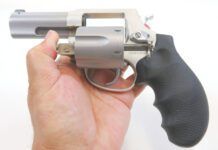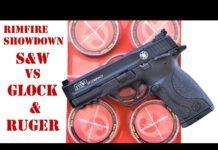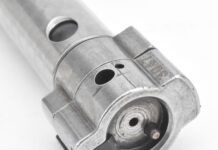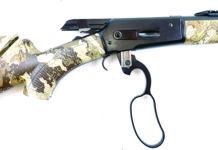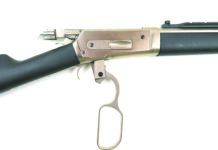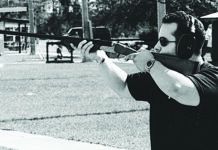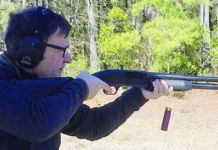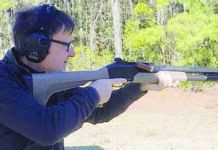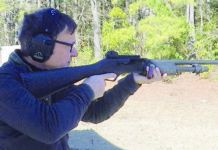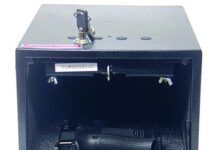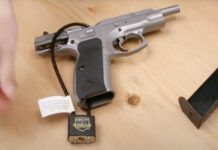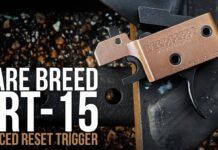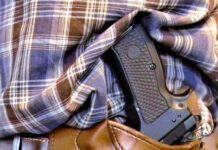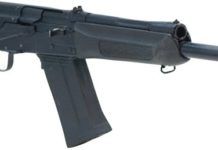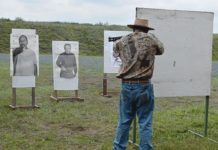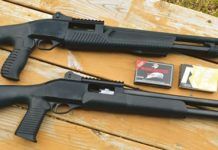Finding the right shotgun for a combination of field shooting and sporting clays competition is quite a trick. The diverse demands of bird hunting—quick shots at hard-flying quail, passing shots at dove and ducks, and incoming shots at decoyed geese—combined with the challenge of odd angles on small clay targets—requires a gun that comes up fast but swings smoothly. It’s also a plus if it has a good trigger and is durable and reliable enough to endure the pounding that clay-target shooting gives a gun.
Two 12-gauge over/under shotguns we thought might fill those requirements include the $1,432 Citori Lightning Grade I, which comes with 28-inch barrels and three Invector Plus choke tubes (I/C, Modified and Full). Another was Ruger’s Red Label KRL-1227, a $1,369 list shotgun with 28-inch barrels and five choke tubes (two Skeet, one each I/C, Modified and Full). We shot these guns in a combination of field and range work to see which one we would buy for double duty on birds and clays. Here’s what we thought of each one:
How We Tested
We ran both range and field trials with these shotguns. The range trial included chronographing various shotshell velocities, which we performed with an Oehler 35P chronograph. We set the skyscreens 2 feet from the muzzle to ensure the equipment read the shot string as a unit. If the screens are farther away, the string begins to spread out, which can cause false velocity readings.
We also checked the guns for their point of impact, using a Versa-Rack with field stand to hold a 48-inch-wide roll of craft paper. We then overlaid a 30-inch clear-plastic disk to locate the center of the pattern and its relation to the original red aiming point. We shot three shots on the paper in this trial.
To check patterns on each choke, we shot five shots into the paper at 40 yards. For each choke trial, we counted the number of pellets inside a 30-inch circle and averaged the totals to calculate our percentages. Here’s what we thought of each gun:
Citori Lightning Grade I
The upland-bird hunter can take his pick of Browning over-and-under shotguns. Our pick for this test was a Lightning Grade I Citori, which is one of the company’s best sellers. The gun measured 46 inches in overall length, more than half of which was consumed by its 28-inch barrels. The gun weighed 7.25 pounds. The stock’s length of pull was 14 inches with a 1-inch field pad that offered some relief when testing heavy shotshell loads. We applied several coats of STP Son-of-a-Gun to make the rubber pad slide more easily into the shooting position. The pistol-grip buttstock had 1.5 inches of drop at the comb and 2.5 inches at the heel. We found this gun to have no cast, which makes it shootable for left- or right-hand shooters right out of the box. The high-gloss polyurethane finish was evenly applied and very shiny. In fact, it was too shiny for our tastes, and slick when wet.
In our humble estimation, this gun would have looked better with a satin finish on the stock and barrels to stop light reflection in the field—why announce where you’re standing? All metal on this gun was blued steel. The stock is straight-grain walnut with cut checkering on the pistol grip and forend. The rib was 0.3 inch wide. It had a checkered matte finish and no taper. A 0.15-inch front bead is standard on the gun.
This test gun came with 3-inch chambers to handle a wide range of 2.75-inch to 3-inch loads. To help reduce chamber pressure and improve pattern percentage, we would lengthen the Citori’s 1inch forcing cones another 2 to 2.5 inches and polish them. This should help reduce felt recoil. Such work costs about $100.
The bore size on this test gun was 0.738 inch on the bottom barrel and 0.739 inch on the top barrel. Browning advertises the guns to have a 0.745-inch bore, but of all the hundreds of gun we have looked at 0.740 inch seems to be the average. Most aftermarket choke manufacturers use 0.740 inch as the staring bore size. The Invector Plus chokes we received with this gun were Improved Cylinder at 0.005-inch constriction, Modified at 0.012 inch, and Full at 0.030 inch. In our pattern testing we found the I/C gave us from 44 to 53 percent with an average of 47 percent with all of our test ammunition. The Modified patterned at 54 percent on average and 67 percent in the Full choke. Point of impact for both barrels was within factory tolerance at 4 inches.
The trigger pull on the bottom barrel was 5.5 to 5.75 pounds; the top barrel’s trigger pull ranged between 4.5 to 4.75 pounds. Both triggers had a crisp release. This gun is set up with an inertia block for the second shot. A top-tang manual safety is marked O and U for easy first-shot setup.
Our testers said the Citori mounted quickly in different target presentations, and we found the gun mounted well from the normal down-gun field-carry position. However, some testers complained that the grip felt too thick, and some had trouble mounting the gun consistently because of the straight stock. Also, the action operated stiffly. We think all friction points on the action should be coated with a lightweight grease to speed break-in and make the gun open and close more easily.
Ruger Red Label
The KRL-1227 Red Label we tested cost $1,369 MSRP. The gun is one of several 12-gauge shotguns Ruger offers. Our test gun has the familiar Red Label pistol grip that started the company’s shotgun line. The blued-steel barrels, which contrast with the stainless receiver, make this a sharp-looking line of shotguns.
Our test gun had a walnut stock that contained good wood figure, particularly some fiddleback in the buttstock. It had a rounded forend with cut checkering on the sides. The gun’s overall length was 45 inches, and it weighed 8 pounds. Its length of pull was 14 inches with a half-inch solid rubber pad that we thought needed to be replaced with a good Pachmayr 1-inch pad to soften recoil a bit. Drop at the comb was 1.5 inches and 2.25 inches at the heel. The stock had no cast.
One of the Ruger’s best features was how easy the top lever opens. This can be a plus for those who find opening o/u barrels hard to handle. The top-tang safety, with its B and T markings, returned to safe with each opening—a good safety feature for beginners. This gun comes with 3-inch chambers and 1-inch forcing cones that need to be lengthened, in our opinion. This test gun had mechanical triggers with pull weights at 4.25 to 4.5 pounds on the bottom and 4.5 to 5 pounds when the top barrel was selected. We felt a little creep on the sears of the Red Label trigger.
The bores on this gun were 0.744 inch. The oversize diameters of these bores helps reduce pressure, thus shot deformation, which in turn helped pattern performance. Five chokes are supplied with this model. The two Skeets employ 0.003 inch of constriction. The Improved Cylinder had 0.010 inch, Modified 0.015 inch, and Full 0.022 inch. Patterns on this gun were similar to the Citori in overall percentage performance, as the accompanying table shows.
After shooting the Red Label, our testers complained of kick up into the face of the shooter, and they said this gun recoiled more than others we’ve tested. One shooter had a sore middle finger after shooting the heavy loads we used in this test. Also, we thought this gun felt heavy and came to mount more slowly than the others. In short, we thought it wasn’t as nimble as the Citori gun.
Gun Tests Recommends
Citori Lightning Grade I, $1,432. Buy it. The Citori Lightning is a good buy for the shooter who is looking for a shotgun that can handle birds and some clay target shooting. To make the gun more shootable, we suggest you employ a competent gunsmith to lengthen and polish the Citori’s forcing cones. Also, if you need to adjust the stock for a different length of pull, install a different recoil pad.
Ruger Red Label KRL-1227, $1,369. Conditional Buy. The Ruger Red Label is a good shotgun, but in our testing, we didn’t think that it handled as well as the Browning.
Also With This Article
[PDFCAP(3)] [PDFCAP(4)].


